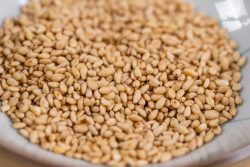kimchi fried rice 泡菜炒飯

Kimchi fried rice, known as “kimchi bokkeumbap” in Korean, is a popular dish that combines the traditional Korean staple, kimchi, with fried rice. It has become a beloved comfort food in Korean cuisine and has gained international popularity in recent years. The history of kimchi fried rice can be traced back to the cultural and culinary traditions of Korea.
Kimchi itself has a long history in Korean cuisine, dating back thousands of years. It is a traditional fermented vegetable dish made primarily from cabbage, radishes, or other vegetables, mixed with seasonings such as chili pepper, garlic, ginger, and salt. Kimchi was originally developed as a way to preserve vegetables for the harsh Korean winters when fresh produce was scarce.
Fried rice, on the other hand, has Chinese origins and has been a part of East Asian cuisine for centuries. The technique of stir-frying rice with various ingredients was introduced to Korea through cultural exchanges with China.
The exact origin of kimchi fried rice is not well-documented, but it is believed to have emerged as a way to repurpose leftover rice and kimchi. In Korean culture, using leftovers to create new dishes is a common practice known as “sikye,” which aims to minimize food waste.
Kimchi fried rice typically consists of cooked rice stir-fried with kimchi, along with additional ingredients such as diced vegetables, meat (often bacon or pork), and sometimes a fried egg on top. The kimchi adds a tangy, spicy flavor to the rice, while the fermentation process of kimchi gives it a unique and complex taste.
Over time, kimchi fried rice has evolved and gained popularity both within Korea and internationally. It is now a staple in many Korean households and is also found on the menus of Korean restaurants worldwide. It is often enjoyed as a quick and satisfying meal, and variations of the dish can include different proteins, spices, and vegetables to suit individual preferences.
The popularity of kimchi fried rice can be attributed to its delicious taste, the widespread love for kimchi, and the convenience of preparing a satisfying meal using simple ingredients. Today, kimchi fried rice continues to be a beloved and iconic dish in Korean cuisine, representing the harmonious blend of traditional flavors and modern culinary creativity.
Ingredients
250g cooked rice
100g kimchi
1 tablespoon oil
1 tablespoon sesame seeds
1 tablespoon Chili powder
1 tablespoon sugar
1 tablespoon soy sauce
1 tsp salt and pepper
a little seaweed if you have
~50g spring onion
1 tablespoon sesame oil
Udon noodles
1/2 deciliter liquid from sauerkraut
100g kimchi
1 package udon noodles
salt and pepper
1 teaspoon chili paste
1 tablespoon sugar
1 tablespoon soy sauce
30g spring onion
1 tablespoon sesame seeds
1.5 tbsp oil
Version with Udon noodles and meat
You can use almost any type of meat and sausage you like.
We used some Beef meat rolls, same type as we use when having HotPot. (Video to come later this year)
Other-vice same as the above.
原料
250克熟米飯
1 0 0克泡菜
1湯匙油
1湯匙芝麻籽
1湯匙辣椒粉
1湯匙糖
1湯匙醬油
1茶匙椒鹽
少許海藻如果你有
~5 0克蔥
1湯匙芝麻油
烏冬面版
1 /2分升泡菜裡的液體
100克泡菜
1包烏冬面
椒鹽
1茶匙辣椒醬
1湯匙糖
1湯匙醬油
30克蔥
1湯匙芝麻籽
1.5湯匙油
烏冬面和肉的版本
你可以使用任何你喜歡的肉和香腸。
我們用了一些薄片牛肉捲,和我們吃火鍋時用的一樣。 (視頻將於今年晚些時候發布)
其他同上。












Shopping link


This is the heading
Lorem ipsum dolor sit amet, consectetur adipiscing elit. Ut elit tellus, luctus nec ullamcorper mattis, pulvinar dapibus leo.

This is the heading
Lorem ipsum dolor sit amet, consectetur adipiscing elit. Ut elit tellus, luctus nec ullamcorper mattis, pulvinar dapibus leo.

This is the heading
Lorem ipsum dolor sit amet, consectetur adipiscing elit. Ut elit tellus, luctus nec ullamcorper mattis, pulvinar dapibus leo.

This is the heading
Lorem ipsum dolor sit amet, consectetur adipiscing elit. Ut elit tellus, luctus nec ullamcorper mattis, pulvinar dapibus leo.

This is the heading
Lorem ipsum dolor sit amet, consectetur adipiscing elit. Ut elit tellus, luctus nec ullamcorper mattis, pulvinar dapibus leo.

This is the heading
Lorem ipsum dolor sit amet, consectetur adipiscing elit. Ut elit tellus, luctus nec ullamcorper mattis, pulvinar dapibus leo.

